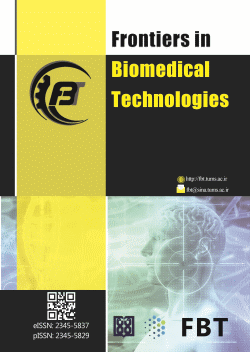Internal Dosimetry in Patients Undergoing Peptide Receptor Radionuclide Therapy (PRRT) with 177Lu-[DOTA0-Tyr3] Octerotate: A Single-Center Experience
Abstract
Purpose: Peptide Receptor Radionuclide Therapy (PRRT) with 177Lu-DOTATATE (177 Lu DOTA-TATE therapy is a form of PRRT which targets Somatostatin Receptors (SSR). It is a form of targeted drug delivery, which is applicable to treat neuroendocrine tumors. PRRT applications are continuously expanding in most departments of nuclear medicine in Iran, but the best of all, no one has studied the mean doses of organs of the patients. This research aims to specify the absorbed dose to patients for the treatment of neuroendocrine tumors using imaging with 177Lu-[DOTA0-Tyr3] octerotate.
Materials and Methods: Whole body planar scintigraphy images were collected for 10 patients, which are used as the basis for the personalized patient dosimetry calculations. The patients had a mean age of 53.5 ± 12 years (ranging from 36 to 70 years) and imaging data were collected at roughly 0 to 2 hours, 4 to 6 hours, 18 to 24 hours, and 36 to 48 hours after the injection of 6401± 628.4 MBq (range of 5500 MBq-7400 MBq) of 177Lu-[DOTA0-Tyr3] octerotate. Models of time-activity were established for different organs. Finally, using absorbed dose formulation and IDIAC-Dosage software, the mean absorbed dose in the organs was determined.
Results: Mean calculated dose in the kidney and liver were obtained as 0.30-0.82 mGy/ MBq, and 1.05-2.11 mGy/MBq, respectively.
Conclusion: Based on the results, PRRT therapy is a safe method for the treatment of castration-resistant neuroendocrine cancer patients in terms of patient dose. Large inter-individual differences in organ dose were discovered, highlighting the importance of patient-specific dosimetry and treatment planning in the treatment with 177Lu-DOTATATE.
2- Anja Rinke et al., "Placebo-controlled, double-blind, prospective, randomized study on the effect of octreotide LAR in the control of tumor growth in patients with metastatic neuroendocrine midgut tumors: a report from the PROMID Study Group." Vol. 27 (No. 28), pp. 4656-63, (2009).
3- Ernesto Amato, Alfredo Campennì, Astrid Herberg, Fabio Minutoli, and Sergio Baldari, "Internal Radiation Dosimetry: Models and Applications." in 12 Chapters on Nuclear Medicine: IntechOpen, (2011).
4- Mattias Sandström, Ulrike Garske, Dan Granberg, Anders Sundin, Hans %J European journal of nuclear medicine Lundqvist, and molecular imaging, "Individualized dosimetry in patients undergoing therapy with 177 Lu-DOTA-D-Phe 1-Tyr 3-octreotate." Vol. 37pp. 212-25, (2010).
5- Roelf Valkema et al., "Long-term follow-up of renal function after peptide receptor radiation therapy with 90Y-DOTA0, Tyr3-octreotide and 177Lu-DOTA0, Tyr3-octreotate." Vol. 46 (No. 1 suppl), pp. 83S-91S, (2005).
6- Marta Cremonesi, Mahila Ferrari, Lisa Bodei, Giampiero Tosi, and Giovanni %J Journal of nuclear medicine Paganelli, "Dosimetry in peptide radionuclide receptor therapy: a review." Vol. 47 (No. 9), pp. 1467-75, (2006).
7- Bahman Emami et al., "Tolerance of normal tissue to therapeutic irradiation." Vol. 21 (No. 1), pp. 109-22, (1991).
8- JS %J Physics in Medicine Fleming and Biology, "A technique for the absolute measurement of activity using a gamma camera and computer." Vol. 24 (No. 1), p. 176, (1979).
9- Martin Andersson, Lennart Johansson, Keith Eckerman, and Sören %J EJNMMI research Mattsson, "IDAC-Dose 2.1, an internal dosimetry program for diagnostic nuclear medicine based on the ICRP adult reference voxel phantoms." Vol. 7pp. 1-10, (2017).
10- MA Said, MA Masud, MZ Zaini, RA Salleh, BN Lee, and R Zainon, "Lu-177 DOTATATE dosimetry for neuroendocrine tumor: single center experience." in Journal of Physics: Conference Series, (2017), Vol. 851 (No. 1): IOP Publishing, p. 012017.
11- Michael G Stabin, Fundamentals of nuclear medicine dosimetry. Springer Science & Business Media, (2008).
12- Melanie Hohberg et al., "Lacrimal glands may represent organs at risk for radionuclide therapy of prostate cancer with [177 Lu] DKFZ-PSMA-617." Vol. 18pp. 437-45, (2016).
13- Mark W Konijnenberg, Magda Bijster, Eric P Krenning, and Marion %J Journal of Nuclear Medicine De Jong, "A stylized computational model of the rat for organ dosimetry in support of preclinical evaluations of peptide receptor radionuclide therapy with 90Y, 111In, or 177Lu." Vol. 45 (No. 7), pp. 1260-69, (2004).
14- Michael G Stabin and Jeffry A %J Health physics Siegel, "Physical models and dose factors for use in internal dose assessment." Vol. 85 (No. 3), pp. 294-310, (2003).
15- Jack %J Annals of the ICRP Valentin, "Basic anatomical and physiological data for use in radiological protection: reference values: ICRP Publication 89: Approved by the Commission in September 2001." Vol. 32 (No. 3-4), pp. 1-277, (2002).
16- Walter S Snyder, Mary R Ford, Gordon G Warner, and HL Fisher Jr, "Estimates of absorbed fractions for monoenergetic photon sources uniformly distributed in various organs of a heterogeneous phantom." Oak Ridge National Lab., Tenn., (1969).
17- Irini Baka et al., "Value of Individualized Dosimetry in Peptide Receptor Radionuclide Therapy (PRRT) by Lutetium-177 [177 lu–Dota 0, Tyr 3] Octreotate." Vol. 9 (No. 3), (2014).
| Files | ||
| Issue | Vol 12 No 1 (2025) | |
| Section | Original Article(s) | |
| DOI | https://doi.org/10.18502/fbt.v12i1.17731 | |
| Keywords | ||
| Individualized Dosimetry 177Lu-DOTA0 Tyr3-Octreotate Neuroendocrine Tumors Organ at Risk | ||
| Rights and permissions | |

|
This work is licensed under a Creative Commons Attribution-NonCommercial 4.0 International License. |




